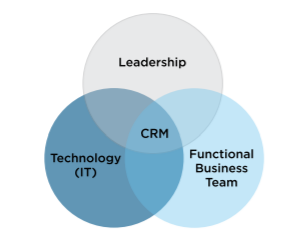In Brief
When it comes to articulating the value of new customer relationship management (CRM) technology, building a strong partnership between the business and the technology organization is imperative — especially in the critical period that follows deployment. Sustaining transformation and maximizing the return on your organization’s investment in CRM hinges on aligning the right mix of people, processes and technology across the enterprise.
Is your CRM technology living up to its promise?
In a world of continuous disruption and accelerating change, CRM technology has the power to fuel growth and enable transformation by bringing the customer experience into focus. Yet according to Forrester’s U.S. 2019 Customer Experience Index, U.S. brands fall short of providing quality customer experiences. While this year’s index inched upward 0.4 points, overall progress over the past four years has remained stagnant.
In a 2019 Argyle Executive Forum survey conducted in partnership with Huron, only 47% of leaders believe their customer experience processes are optimized to maximize the return on their CRM investment. A similar minority (45%) felt their organization was getting the fullest possible value from its CRM solution.
For many organizations, the difference between unleashing the full potential of new technology and falling short of expectations lies in the resources they invest in the post-deployment production management effort — a crucial yet often overlooked leg of the journey to CRM transformation.
Balancing the Post-Deployment Plan
To avoid common pitfalls like wasted time and effort on ill-conceived CRM initiatives, organizations should focus on creating and articulating long-term business value. Rather than relying on internal information technology (IT) resources to manage the post-deployment production management effort, organizations can entrust a functional business team to drive adoption and optimization of the new system, balancing two goals:
- Adopt the customer experience mindset. Communicate the value of delivering the differentiated customer experience envisioned by leadership.
- Unite the business and IT teams. Mandate collaboration between the functional business team and the technology organization.
Adopt the Customer Experience Mindset
Mapping the postproduction plan to the customer experience is more than a technical exercise; it requires a thoughtful strategy that cuts across multiple business lines and functions.
Entrusting business leaders to communicate the value of new CRM technology primes the organization for adoption of the customer experience mindset. For employees seated throughout the company, this translates to connecting the “what” to the “why”— a critical strategy in driving adoption, enacting disruptive process changes, and achieving the cultural shift that the project sponsors and senior management teams envisioned when investing in new technology.
Unite the Business and IT Teams

When building a coalition of functional business leaders to lead this leg of the journey, organizations should align resources to support a range of interconnected responsibilities:
- Aligning the strategic vision. Assigning a business owner to oversee the post-deployment management plan keeps the CRM strategy alive and breathing and allows the organization to adapt when shifts in market trends, customer preferences, and behaviors present new challenges and opportunities. Achieving this level of agility hinges on strategic alignment across the project management office, developers, middle management and end users — a key responsibility that should not be overlooked.
- Managing the cultural shift. Empowering business leaders to drive the agenda for post-implementation projects like releases and upgrades helps the business view new technology as fluid and evolving to support emerging needs and goals.
- Prioritizing requirements and effort. When developing the postproduction road map for improvements, entrusting business resources to communicate requirements and system limitations ensures that post-deployment development plans best serve the business and IT needs.
- Driving adoption. Empowering business leaders to educate users on the functionality of new tools and the value they bring to the business requires a two-way messaging plan. Business leaders must connect the dots between data and clients, business processes and performance, and clicks of the mouse and business value. And end users should feel welcome to communicate their ideas for further development and share in the ownership of new tools.
- Ensuring data quality. Establishing a governance team that mirrors the hierarchical structure of your company is a critical tenet of a mature CRM data management infrastructure. Entrusting a team to review, adjust and input critical data ensures seamless accuracy and accountability across key segments of the business.
- Unlocking customer data. Experts in business intelligence, reporting and analysis should partner with the technology organization to make sure the new system promotes the data needed to inform business decisions, and that systems are optimized to harness the powerful insights CRM data provides.
Organizations that treat CRM as a business tool and align support for these important success drivers will see increased value in their systems and, in turn, achieve a greater return on their investment.
